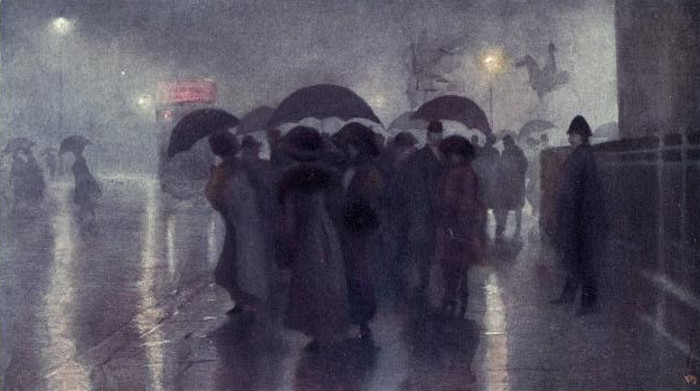A charming puzzle from Crux Mathematicorum, December 2004:
If all plinks are plonks and some plunks are plinks, which of these statements must be true?
X: All plinks are plunks.
Y: Some plonks are plunks.
Z: Some plinks are not plunks.
A charming puzzle from Crux Mathematicorum, December 2004:
If all plinks are plonks and some plunks are plinks, which of these statements must be true?
X: All plinks are plunks.
Y: Some plonks are plunks.
Z: Some plinks are not plunks.

“A little boy and a little girl were looking at a picture of Adam and Eve. ‘Which is Adam and which is Eve?’ said one. ‘I do not know,’ said the other, ‘but I could tell if they had their clothes on.'” — Samuel Butler, Notebooks, 1912

Here are six new lateral thinking puzzles — play along with us as we try to untangle some perplexing situations using yes-or-no questions.

This image turned up in the subreddit Confusing Perspectives back in February.
One user wrote, “Someone needs to make this into real sheet music and see how it sounds. I’m curious now.”
Another version:
https://www.youtube.com/watch?v=MT5erpy3kOA

Only a few years back those who carried Umbrellas were held to be legitimate butts. They were old fogies, careful of their health, and so on; but now-a-days we are wiser. Everybody has his Umbrella. It is both cheaper and better made than of old; who, then, so poor he cannot afford one? To see a man going out in the rain umbrella-less excites as much mirth as ever did the sight of those who first — wiser than their generation — availed themselves of this now universal shelter.
— William Sangster, Umbrellas and Their History, 1855
In 1899 Notes & Queries reprinted an account, now thought to be apocryphal, of “the first silk hat in London”:
It was in evidence that Mr. Hetherington, who is well connected, appeared upon the public highway wearing upon his head what he called a silk hat (which was offered in evidence), a tall structure, having a shiny lustre, and calculated to frighten timid people. As a matter of fact, the officers of the Crown stated that several women fainted at the unusual sight, while children screamed, dogs yelped, and a young son of Cordwainer Thomas, who was returning from a chandler’s shop, was thrown down by the crowd which had collected and had his right arm broken.
Supposedly Hetherington argued that he’d broken no law, and the Times backed him up: “In these days of enlightenment it must be considered an advance in dress reform, and one which is bound, sooner or later, to stamp its character upon the entire community.”

For years, under a “gentleman’s agreement,” the Philadelphia Art Commission would approve no new structure that rose higher than the statue of William Penn atop city hall. Then, in March 1987, it approved One Liberty Place, a steel-and-glass skyscraper that rose 121 meters above Penn’s head.
In the next 22 years no major professional sports team based in Philadelphia won a championship.
Finally, in 2007, during the completion of the 297-meter Comcast Center downtown, workers John Joyce and Dan Ginion attached a small figurine of Penn to its topmost beam. The following year, the Philadelphia Phillies won the World Series.
In 2017 another Penn statuette was placed atop the newly completed 342-meter Comcast Technology Center. “They did not want to take the chance and wait for the jinx,” said the building’s construction manager. A few months later, the Eagles won the Super Bowl.
In “The Adventure of the Empty House,” an old book collector visits John Watson’s house, “his precious volumes, a dozen of them at least, wedged under his right arm.” He says, “Maybe you collect yourself, sir; here’s British Birds, and Catullus, and The Holy War — a bargain every one of them. With five volumes you could just fill that gap on that second shelf.”
Now, this must mean either that two of the titles comprised two volumes apiece or that one comprised three volumes, a point first made by Magistrate S. Tupper Bigelow. But which is it? In the strangely half-specified world that Holmes and Watson inhabit, the fact of the matter seems not to exist.
Philosopher Terence Parsons asks whether Holmes has a mole on his back. Since the stories are silent on this point, it seems that he neither has one nor doesn’t.
See Truth and Fiction.
In 2013, University of Minnesota geography student Daniel Crawford composed “A Song of Our Warming Planet,” a solo cello piece built on climate data. The pitch of each note corresponds to the average annual surface temperature of a year in the range 1880-2012 in data from NASA’s Goddard Institute of Space Studies; each ascending halftone represents roughly 0.03°C in planetary warming.
“Climate scientists have a standard toolbox to communicate their data,” Crawford said. “We’re trying to add another tool to that toolbox, another way to communicate these ideas to people who might get more out of music than maps, graphs, and numbers.”
Below: He later applied the same method to create a string quartet using data from 1880 to 2014. The four parts reflect the average annual temperatures in four regions: the cello the equatorial zone, the viola the mid-latitudes, and the violins the high latitudes and the arctic.
Prove that if seven darts land on a dartboard, there will always be two darts that are no farther apart than the distance of one radius.
In 2014, Italian artist Sven Sachsalber set out literally to find a needle in a haystack.
The performance, undertaken at the Palais de Tokyo in Paris, was allotted two days. Amazingly, Sachsalber found the needle with a few hours to spare.
Now we need a new saying.